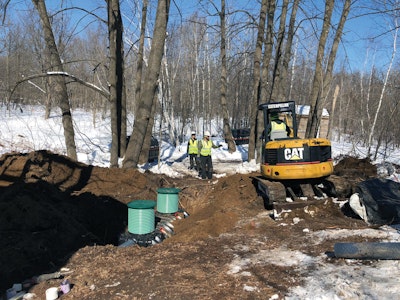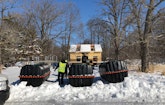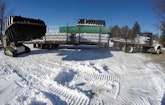
Kyle Wade of Septic Check helps set one of the Infiltrator Water Technologies IM-1060 tanks that formed the primary treatment chain for the system on Farm Island in Minnesota.
Although most installation work shuts down when winter comes to the north, one crew in Minnesota was waiting for the snow and ice so they could get their job done. Winter was the best time to put in a new treatment system for a house on an island.
Minnesota has many lakes and many islands, but not all the lakes or all the islands are easy to reach, says Travis Johnson, production manager for Septic Check in Milaca, Minnesota. Johnson handles the design, inspection and installation division of the multiservice company. On large lakes — such as Minnetonka, which is about 4 miles long by 3 miles wide and is near the Twin Cities — you can expect to find a barge company to tote materials to island construction sites, he says. On smaller lakes that’s not the case, which means an installer either pays for someone to haul a barge to the lake or finds another way to move equipment and components. The Septic Check crew chose a different solution: driving across the ice.
Farm Island is about 1,200 feet long by 1,200 feet wide and sits near the southern end of Farm Island Lake near Aitkin. The lake is about 120 miles north of Minneapolis. There are other homes on the island, but the job for Septic Check was to install a new onsite system for a year-round recreational dwelling of about 1,400 square feet.
Minnesota regulations require a minimum separation of 3 feet between the drainfield of a conventional system and the water table. A mound system would have met that requirement, but hauling aggregate to the island would have been a problem. You either move three-quarters of a yard at a time in a skid-steer, Johnson says, or you drive a dump truck and risk the life of the driver and the loss of the truck if it falls through the ice. “And we would not carry that risk,” he says.
The designer instead chose to use an aerobic treatment unit. This option reduced the required separation, and the inclusion of a UV lamp dropped it to 1 foot.
The system
From the house, wastewater exits in a 4-inch Schedule 40 PVC pipe running about 12 feet to the first of three Infiltrator Water Technologies IM-1060 1,000-gallon tanks. This first tank is for settling and anaerobic treatment.
From there, water flows by gravity into the second tank where an ECOPOD E50 unit from Delta Treatment Systems provides aerobic processing. Water leaves the ECOPOD and flows by gravity through a SALCOR UV light and then to the last Infiltrator Water Technologies tank, where a Goulds Water Technology, a Xylem brand, PE51 pump sends it 65 feet through a 2-inch pipe to the absorption field.
The field is 585 square feet and uses 200 linear feet of EZflow by Infiltrator divided into three beds fed by a manifold of 2-inch pipe. The beds are of varying sizes to make maximum use of a small patch of good soil on the 1-acre lot. The system sits behind the house, at the northwestern corner of the property and about 250 feet from the lakeshore.
The system is controlled by a Delta Treatment Systems CPR52RCT15SUV control panel.
Risers were cut from a large piece of Ultra-Rib pipe (IPEX USA) and were secured with Infiltrator Water Technologies lids.
Ice and snow
Installation happened in early March 2018, but preparation began in fall 2017. That’s when the building contractor covered the installation site with frost blankets. These are insulating covers that trap heat from the soil and prevent it from freezing. In February, Johnson went to the island and looked under the frost blankets. The soil was unfrozen, and with final approval from the county, the job was on.
The Septic Check crew brought over a truck with a snowplow and made a road across 3,400 feet of ice to reach the island.
“By the time the job started, we were dealing with 26 to 34 inches of ice on the lake, plenty for smaller trucks,” Johnson says.
Equipment and supplies went across on a trailer pulled by a single-axle flatbed truck. During the five days of construction, the technicians commuted by snowmobile, and every morning they had to make sure there was enough fuel for the snowmobiles. Equipment stayed on the island overnight, and because there was power, the crew could plug in block heaters to make morning starts easier.
That does not mean working across ice was easy.
A large snowfall hit just before the job started. That extra foot of snow put added weight on the ice. Water is squeezed to the top of the ice, and at night it froze. In the morning, drivers face an inch of ice on top of 6 inches of water on top of 36 inches of ice base. It made driving interesting, Johnson says.
“Fortunately we all grew up in Minnesota so we were used to seeing that,” he says.
Everyone watched the weather forecast closely. As spring comes to the north, ice goes through a freeze and thaw cycle. Snowmelt from the shore runs onto lakes and deteriorates the ice until it resembles a honeycomb, and that’s when it’s dangerous to cross, Johnson says. There was no extended period of warming during the project, yet the crew used an auger to bore holes regularly and check the thickness and quality of the ice. It stayed safe through the project.
To do the job, the crew used a 2008 Cat 304 mini-excavator and a 2014 Cat 279D skid-steer.
Island work
“Anytime you work on an island, you double-check everything,” Johnson says. You build the job on paper a few more times than usual, you check the parts list four or five times, and you bring extra pipe, fittings and so on. For this winter job, he made sure there were extension cords to plug in block heaters at night and extra fuel filters for the diesel engines because fuel tends to gel in extreme cold.
“You make sure you have all the little stuff that otherwise you would run to the store to get. Island work is just more planning,” he says.
Once on the island, the job went smoothly. The hardest part was the need to clear all piles of dirt in the course of a day because they would freeze if they sat overnight. It added another item to the scheduling.
Planning for an island job also requires allowing time for the noninstallation work. People will ask, could you move this rock or dig a trench here — and you can’t blame them because heavy machinery doesn’t show up on islands very often so they want to take advantage of it, Johnson says.
And the result of this job for Septic Check was — more work.
“I have three island jobs that I’m working on right now,” he says.
As he begins his planning, the first challenge is the same one he faced on Farm Island: How does he get equipment to the next jobs?









